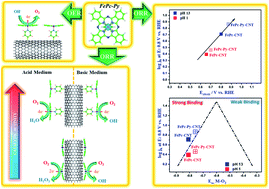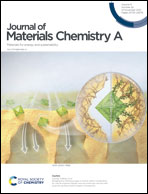Insights into the electronic structure of Fe penta-coordinated complexes. Spectroscopic examination and electrochemical analysis for the oxygen reduction and oxygen evolution reactions†
Abstract
Fe phthalocyanine was coordinated to pyridine-modified carbon nanotubes and studied as a catalyst for the oxygen reduction (ORR) and oxygen evolution reactions (OER). X-ray photoelectron spectroscopy (XPS), Mössbauer, and electron paramagnetic resonance spectroscopy (EPR) analysis supported that pyridine acts as an axial ligand to yield penta-coordinated catalytic active Fe sites. The impedance analyses show an increase in the double-layer capacitance (Cdl) value, corroborating the adsorption of the complexes to give FePc-Py-CNT. The evaluation of the electrocatalytic activity for the ORR was performed in both acid (0.1 M H2SO4) and basic (0.1 M KOH) media, while the evaluation of the OER activity was investigated only in alkaline medium. DFT studies revealed an increased length in the Fe–N binding of the pentacoordinate Fe-based site, leading to a decreased O2–Fe binding energy, explaining the higher ORR and OER activity of FePc-Py-CNT relative to FePc-CNT.



 Please wait while we load your content...
Please wait while we load your content...